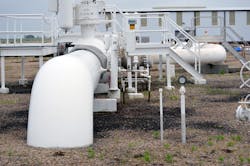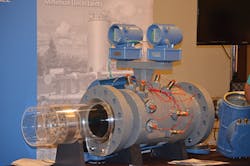The world’s search for energy has put a new emphasis on gas flow measurement. Increasingly demanding requirements are driving changes in gas flowmeter technology, especially in the area of custody transfer measurement. As a result, the market for custody transfer of natural gas has become one of the fastest-growing niches in the flowmeter industry.
Producers are extracting gas from hard-to-reach places — offshore, under shale, in sand, and from dairy farms and landfills in the form of biogas. They are working to conform to changing standards for hazardous and other conditions. Gas producers are seeking to maximize profits and optimize efficiency with greater accuracy, and get a better picture of what is happening in real time.
The impact of fracking
The implementation of hydraulic fracturing, or "fracking," in shale plays has had a major impact on the energy industry. Shale is one of the most common types of rock that contains oil and gas. Traditionally, wells were drilled vertically until oil or gas was found, or the well was determined to be "dry." Using the horizontal drilling technique, wells are drilled vertically to a point, usually extremely deep, and then are drilled horizontally. This greatly enhances the area under the ground that can be tapped for oil and gas. Then the wells are completed and fracked.
During fracking, water, proppants and chemicals are injected into the well to fracture the shale and prop the cracks open, allowing the trapped hydrocarbons to flow free. While fracking has become widespread in the U.S. during the past eight years, it is also practiced in other countries, such as Australia and Poland.
Fracking has caused some controversy because it uses large amounts of water and disposing of fracking fluids is difficult. While some are concerned that fracking will degrade water quality, it usually occurs 5,000 feet down or lower, which is typically below freshwater tables. Some allegations claim that fracking has caused earthquakes, though the evidence for this is inconclusive. Despite its many benefits, environmental concerns have led to it being banned in regions as diverse as France; Scotland; Wales; Denton, Texas; and Boulder, Colorado.
Apart from any environmental concerns, fracking has been a mixed blessing to the oil and gas industry. In July 2014, oil prices hovered between $90 and $100 per barrel. As fracking in the U.S. ramped up, worldwide oil supply began to exceed worldwide demand beginning in August 2014. This brought oil prices down to the $70-per-barrel range in November 2014. In that same month, the Organization of Petroleum Exporting Countries (OPEC) met and decided not to reduce production to control prices. In the past, OPEC, which controls about one-third of the world’s oil production, has reduced production to raise prices. The result of OPEC’s decision was that prices continued to decline, bottoming out at just over $26 per barrel in February 2016. Since oil and gas prices often move together, natural gas prices declined as well.
The drop in oil prices had a powerful effect on the oil and gas industry. Many oil and gas projects became unprofitable at the lower prices. Many subsea projects, especially, were cancelled or put on hold given the high cost of subsea drilling. More than 70 oil and gas drillers and service companies in the U.S. declared bankruptcy. The downturn also had an effect on the flowmeter industry, and some of the fastest-growing flowmeter markets such as Coriolis and ultrasonic actually declined in 2015.
Fortunately, the oil and gas industry has shown remarkable resilience. In an April 2016 meeting in Doha, Qatar, OPEC once again declined to freeze or cut production. And another meeting on June 2, 2016, produced the same result. In the meantime, oil prices have rebounded to the $50-per-barrel range. And natural gas prices have followed the same pattern as oil prices over the past six months, rebounding in early July to levels not seen since early 2015. While oil and gas prices are hard to predict, prospects are that the steady erosion in supply along with increasing demand will continue to drive prices higher over the next year. Some oil and gas producers have begun to bring projects back, and this trend is likely to continue as long as prices hold steady or go higher.
The Emerson Daniel dual transmitter ultrasonic custody transfer flowmeter
Natural gas — a ‘bridge’ fuel
With all the concerns about the environment, many people are looking for alternatives to coal and oil as energy sources. Wind, solar, geothermal and other renewable energy sources are natural candidates because they are much cleaner than coal and oil, and have much less environmental impact in terms of the emission of greenhouse gases. They also do not have the same type of catastrophic risk as nuclear power. The biggest problem with renewable fuels is not that they are ineffective, but that the technology has not been developed sufficiently to make them competitive from a cost standpoint. While this will happen eventually, it may take many years before renewable fuels can effectively compete on a cost basis with coal, oil and nuclear power.
Natural gas is considered a "bridge" fuel because it burns cleaner than coal and oil, and yet is highly competitive in terms of cost. In addition, while it is still a fossil fuel, it is still in plentiful supply and current reserves could last from 75 to 100 years or even longer. Hence natural gas is seen as an ideal solution to use as a source of energy until renewable technology is developed to the point that it is more widely affordable. This really puts natural gas in the driver’s seat as the current energy source of choice for many applications.
Types of gas
Many types of gas exist, including natural gas, atmospheric gas, fuel gas and compressed natural gas. Air is a mixture of gases, including nitrogen, oxygen, argon, etc. Natural gas is discussed a lot in flow measurement because it plays such a critical role in supplying energy. Like air, natural gas is a mixture of gases. These include methane, ethane, butane, propane and other alkanes. Industrial gases are gaseous materials that are manufactured for use in industry. Examples include oxygen, hydrogen, nitrogen, carbon dioxide, argon and helium. These industrial gases are produced in gas processing plants, much as refined fuels such as gasoline, kerosene, diesel fuel and heating oil are produced in refineries.
Measurement of natural gas
From the time it leaves the wellhead until it reaches its point of use, natural gas is measured at many points along the way. In many cases natural gas travels thousands of miles during this journey. Natural gas that is transported over long distances typically travels via gas pipelines. Gas pipelines are like high-speed highways for natural gas, through which it can traverse long distances in short periods of time. Natural gas pipelines are generally buried in the ground for safety and security reasons.
The need to transport gas over long distances from the wellhead to the point of use has given rise to one of the most important measurements in flow: custody transfer of natural gas. A measurement is considered to be "custody transfer" when ownership of the natural gas passes from one party to another. This could be from a gas-producing company to a pipeline company, from a pipeline company to a gas distribution company, and from a gas distribution company to another gas distribution company that distributes the gas to its point of use. There may be a number of custody transfer "handoffs" along this journey.
The main flowmeter types used for custody transfer of natural gas are ultrasonic, differential pressure, turbine and Coriolis. Ultrasonic is the dominant technology for this application. Ultrasonic flowmeters are popular for custody transfer because they do not have moving parts, are highly accurate and reliable, and can handle pipes of almost any line size. The preferred technology for ultrasonic custody transfer measurement is multipath transit time. This is the technology specified by AGA-9, the report by the American Gas Association that governs the use of ultrasonic flowmeters for custody transfer of natural gas.
New developments in gas flow measurement
A great deal of research has gone into the development of custody transfer meters for natural gas since AGA-9 was approved in 1998. Leading suppliers to this market include SICK, Emerson Daniel and Honeywell Elster. Many multipath ultrasonic meters have four, five or six paths, though some have been built with eight, 12 and even 32 paths. While an additional number of paths does not always equate to higher accuracy, some paths are used for diagnostic purposes. During this time, suppliers have built more reliable transducers, greater stability, real-time diagnostics and higher accuracy into their ultrasonic flowmeters.
One important development is the introduction of dual transmitter ultrasonic flowmeters. These flowmeters provide additional redundancy by independently making two custody transfer measurements of the fluid in a single flow path. This provides verification of meter performance and a complete backup in remote locations. The Emerson Daniel Model 3417 allows for bidirectional measurement, with one set of transducers devoted to forward flow and the other set of transducers devoted to reverse flow. In addition to Emerson Daniel, SICK and Honeywell Elster have introduced similar dual transmitter ultrasonic flowmeters.
A look ahead
While 2015 was a down year for some flowmeter companies, the ramping up of oil and gas prices has already improved the instrumentation climate. With worldwide oil demand increasing 1.3 million barrels per day every year, and supply levels reduced because of deferred projects, all the pieces are in place for a strong rebound in instrumentation in 2017 and beyond. Companies that have been on the sidelines may wish to get ready for the coming boom in the oil and gas markets in 2017.
Jesse Yoder, Ph.D., is president of Flow Research Inc. in Wakefield, Massachusetts, a company he founded in 1998. He has 28 years of experience as an analyst and writer in instrumentation. He holds a U.S. patent on a dual-tube meter design and is the author of The Tao of Measurement, published by The International Society of Automation. Yoder also founded the Flowmeter Recalibration Working Group, which addresses the topic of recalibration frequency. He may be reached at [email protected].



